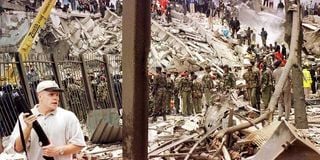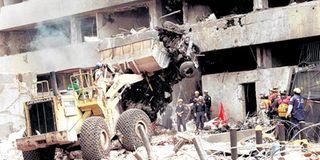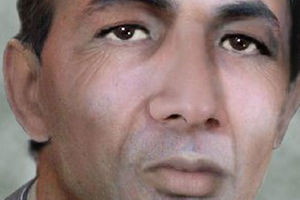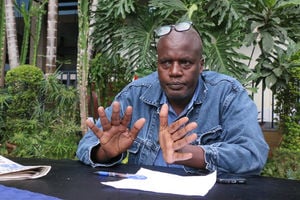
Kenyan and American security officers on site following the bombing of the US Embassy in Nairobi on August 7, 1998. An almost simultaneous bombing was carried out at the US Embassy in Dar es Salaaam, Tanzania.
On July 28, 1998, Kenya's intelligence boss Brigadier Wilson Boinnet sent an urgent message to the United States Embassy in Nairobi.
It was the sort of classified information that intelligence services routinely shared but there was some urgency on this particular cable.
The Americans didn't respond. The Kenyan boss of the Special Branch (predecessor of National Security Intelligence Service) followed up with a phone call.
On Tuesday, August 6, the Nation obtained a copy of the intelligence brief that was shared with the American embassy that day.
“We have learnt of the planned attack on the US Embassy in Nairobi and the Nyali Bridge,” read the intelligence brief. “Prepare accordingly.”
The same brief was shared with the then Commissioner of Police.
Warning
Ten days later, the ominous warning contained in the cable would unfold in horrific fashion.
At 10.30 am, on August 7, 1998, a lorry laden with explosives pulled up at the entrance to the US Embassy off Haile Sellasie Avenue. Armed gun men engaged guards in a shootout at the security barrier. Then there was a loud explosion and the skies above Nairobi darkened with thick smoke and of dust.

An aerial view of the aftermath of bombing of the US embassy in Nairobi. The bomb blast in Nairobi left 218 Kenyans and Americans dead and another 5,000 injured. There was a simultaneous bomb attack in Dar es Salaam on the same day.
About 213 people were killed and an estimated 5,000 wounded.
Almost simultaneously, a bomb exploded at the US Embassy in Dar es salaam, Tanzania, killing 11 and injuring over 85 people.
Terrorist group Al-Qaeda led by Osama Bin Laden claimed responsibility for the attacks.
It would appear the cable from Kenya’s intelligent service on the impending terror plot was ignored.
Days before, the Kenyan security machinery had painstakingly put together information that would have helped foil the attack.
It had all began with an informant, a woman who ran a hotel in Isiolo. She had got wind of the terror plot and shared the information with Archbishop David Gitari. At the time, he was a popular figure, a fiery cleric who took on the authoritarian Kanu regime of President Daniel Moi.
Gitari in turn contacted then Kikuyu MP Paul Muite and shared the same information with him.
In the late 1980s and 1990s, Mr Muite was a leading figure in the fight for multi-party democracy. He served in Parliament between 1992 and 2007.
At the time, there was a poor relationship between the public and the dreaded Special Branch. Kenyans avoided meeting officers from the dreaded unit.

KENYA, Nairobi : (FILES) Rescuers work to help survivors amid the devastation brought in by a bomb explosion in Al-Qaeda’s first major international attack near the US embassy and a bank in Nairobi on August 7, 1998. AFP PHOTO / FILES
On this 26th anniversary of the bombings, the Nation interviewed Mr Muite on events preceding the terror attack.
Mr Muite revealed how he recorded the statement of the woman who had crucial intelligence on the attack. He recalled how he had received a call from Gitari informing him about the woman who had the crucial information that could avert looming bloodshed.
Gitari and Mr Muite had a long-standing friendship and trust forged over many days in the trenches during the struggle for multi-party politics.
The Senior Counsel recalled when Gitari told him that he would send the woman to his office, he did not take it lightly.
Mr Muite met the contact in Nairobi and proceeded to interrogate her on this crucial information. Having satisfied himself that the information from the informant was credible, he recorded her statement.
In the statement, Mr Muite recalled, the informant detailed how she had overhead the planning of the terror attack on the embassy in Nairobi Nyali Bridge in Mombasa.
“We would eventually pass the same information to the intelligence service,” he recollected.
Detailed statement
Mr Muite accompanied the woman to file a formal report with the intelligence service at its headquarters in Nyati House. He was armed with the detailed statement.
At Nyati House, Mr Muite recalled, they found an officer who identified himself as the fourth senior-most officer in the service. The bosses were out of the office.
After a brief discussion on the purpose of the visit, Mr Muite placed the dossier on the terror attack on the table for the officer to peruse.
Mr Muite recalled that after reading through the first pages, the intelligence boss remarked: “Nyali Bridge again?”
It would appear the Kenyan spies had earlier stumbled on intelligence about a terror plot targeting the bridge.

Rescue workers remove the remains of the car bomb that destroyed the US embassy in Nairobi on August 7, 1998. More than 200 people were killed in the attack. PHOTO | FILE
He recalled that after the officer went through the entire statement, he appeared shocked at the details.
This alongside other material collected by the intelligence service would form the basis of the cable to the Americans.
“He told us that they (intelligence service) had picked the same information and shared it with the US Embassy,” Mr Muite recounted.
He said he followed up on the matter days after the bomb blast.
“I can confirm that the US Embassy had all the information but for reasons best known to them, they never acted,” Mr Muite said.
Almost a month after this information was first passed to the security agencies, Mr Muite accompanied the same informant to the intelligence service’s offices at Nyati House. The woman had been summoned to shed more light on the attack that had already taken place.
International investigation
More than 20 suspected Al-Qaeda terrorists have since been charged in connection with the bombings and seven are serving life sentences in US prisons, according to information published by the Federal Bureau of Investigations (FBI).
The prosecutions followed an intense international investigation that involved over 900 FBI agents alone—and many more FBI employees—deployed overseas to recover evidence, identify victims and to track down the perpetrators.
Once the attacks were directly linked to Al-Qaeda, within 20 days of the bombings, Mohammed Sadeek Odeh and Mohammed Rashed Daoud al-Owhali were arrested in Kenya. They were extradited to the US where they were convicted for their roles in the attack and sentenced to life in prison in October 2001.
In September 1998, Wadih el-Hage—a naturalised American citizen who had been living in Texas—was arrested, tried and sentenced to life in prison in 2001. In the same month, Mamdouh Mahmud Salim was arrested in Germany and charged for the embassy attacks. Later, he was jailed for life “for stabbing a federal corrections officer in the eye while in prison”.
On November 4, 1998, Bin Laden and several members of his network, including his military commander Muhammad Atef, were named in an indictment based on the investigation. Both have since been killed.







